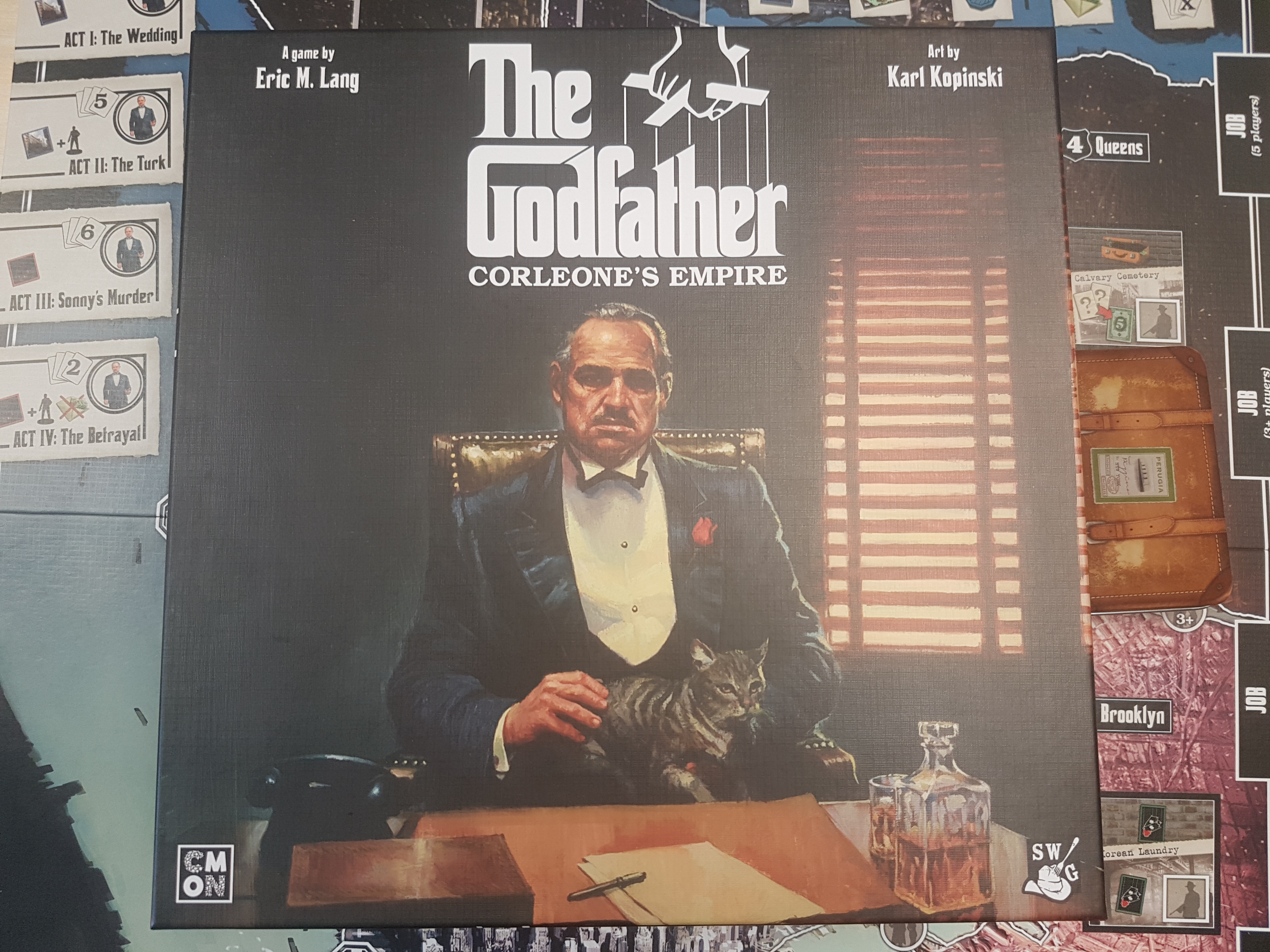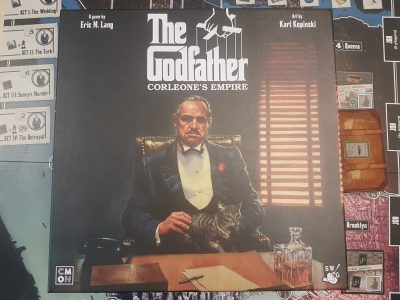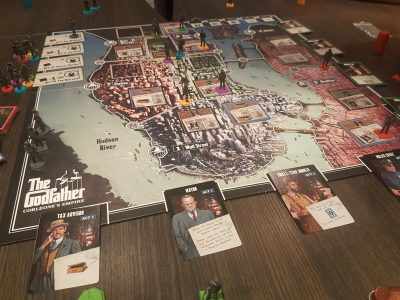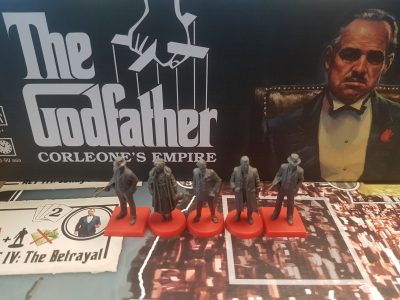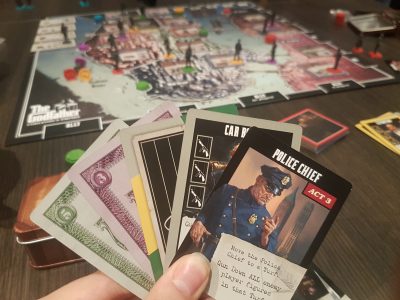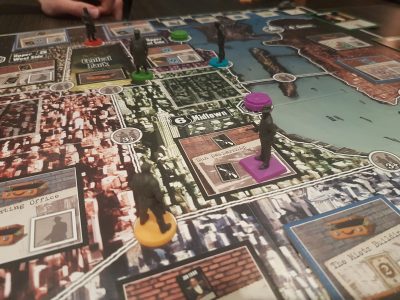The Godfather: Corleone’s Empire is the brand new Eric Lang board game described as an area influence game with worker placement, or in mafia terms “thugs on a map”. Players take up control of families aiming to be in the position to take control of the city, should anything accidental happen to Don Corleone himself. Play time is approximately 90 minutes with time varying depending on which end of the 2 – 5 players’ spectrum you play on. However, does The Godfather: Corleone’s Empire board game give fans an offer they can’t refuse or a reason not to get mixed up in the mafia ways? Let’s find out.
The gameplay is broken down into four almost identical acts made up of distinct phases. Post setup where job cards are shuffled, the board is set up and figures are handed out is, unsurprisingly, Act 1. At the start of each act is the New Business phase. In the first two acts the top most tile is taken from the blue business pile of tiles and added to the board and for the latter two acts a tile is taken from the red business pile. The differences are normally that red businesses offer more in return for being shaken down. As a bonus to this, players receive additional family member figures in Act 2 and 4.
Next up is where the majority of the game will take place, the Family Business phase. In this phase players take it in turns to complete actions. The first two potential actions are figure based and once all your figures are placed you can no longer complete any actions. This is pretty much the only similarity to Eric Lang’s Blood Rage, akin to the Rage tracker. Figures are split into two types Thugs with square bases, that can shakedown the front of a business, and Family member with circle bases, whom can shakedown the back of multiple businesses at once.
As an action a player can place a Thug on any unoccupied business in the square shaped space. This activates the locations ability. These abilities include: taking the horses head (the first player marker), obtaining job cards, being able to put Money from your hand into your suitcase and take illegal good cards. Another action available would be to place a Family Member on any unoccupied circle spaces. These sit along turf borders and activate the back-end abilities of any businesses in adjacent turfs. These are usually the same or similar to the abilities of the front of businesses.
The third available action is to complete a job. This can either be one from the players hand or the communal jobs along the edge of the board. To complete a job players will need to trade in the required illegal goods cards. For completing the job the player not only gains a money reward, the exact money cards shown on the card, but also an instant ability. This is where one of the best bits of The Godfather: Corleone’s Empire comes into play as one of the job abilities is to gun down an opponents’ figure or multiple figures in a turf. Completed job cards are then placed into the player’s suitcase for end game scoring. The final option is to play an ally card which have some normal abilities and a few unique abilities that involve neutral figures. These can shake up the game but often don’t massively swing the way the game is going.
Next up are three quick phases to round the act off. Firstly is the Turf War, where players determine whom has the most influence over the individual turfs. For each turf a player has the most figure in, including family members which are included in multiple turfs, they get to place an influence token. This doesn’t affect the main game but contributes to end game scoring. Then along comes the Bribery phase. Here players will be using money from their suitcases to secretly bid for the available ally cards. Whomever bids the most gets first pick, second most gets second pick and so on until all allies are taken. Finally Tribute to the Don must be paid. Each round has a specified number of cards players can keep in their hands from one act to the next, the rest are simply discarded. Note this is the only time a hand limit is applied. If there is a next act players take their figures back off the board and the game begins at the new business phase.
If this is the final round players must discard all but two cards and if these are money they can be placed in suitcase. A Turf bonus of $5 bonus is then awarded to the player with the most control over each turf individually. If this is tied then the player with then top most influence marker wins the bonus. Job cards come in four colours, whomever has completed the most of a colour gains a $5 bonus with ties resulting in both players getting the bonus. After these bonuses which every player has the most money wins.
As is to be expected, with Cool Mini Or Not is behind the game, the miniatures are of high quality. From the family and thug miniatures to the Don Vito Corleone Act marker, and horse head first player marker, awesomeness oozes from the box. Alas, I’m left feeling the shininess is unwarranted. Each family has unique Don, Consigliere and Heir figures, despite the three being identical gameplay wise. Conversely, all the thugs are identical, bar their coloured bases. For a game which costs as much as it does, it makes sense that there are plenty of unique miniatures. Yet, would the game be any worse off with the coloured bases being the only difference between families? The simple answer is no, the gameplay would not be affected in the slightest.
Following this you may expect me to comment on how the inclusion of metal tin suitcases included in The Godfather: Corleone’s Empire is also overkill. The opposite is true. They do add to the game and are much more robust that other options. The suitcases completely hide the number of cards players have been able to bank, adding to the mystery of whom the current leader is. The lid is even used in the bribery element and they fit the theme nicely of family’s filtering money away from businesses for personal gain.
The licence of The Godfather is utilized throughout the components but fear not for those whom have yet to see the icon films. Aside from the Don Corleone imagery things are more generically themed around the mafia. Concepts of protection money, money laundering and everything that comes with these nefarious activities, such as shakedowns, drugs and someone having the cops in their back pocket are all utilized. It gives a theme that has plenty to hold the game mechanics together without breaking the illusion. It is a solid base that is only built upon by the strong gameplay.
There are some family member locations on the board that are act after act are chosen first. This is because they are adjacent to three turfs. This sounds like it may be over-powered, as that player can shakedown the back of up to six locations and have influence into each of these turfs. Thankfully players will soon have the ability to gun down enemy figures, via completing jobs or allies. These spaces with high influence and shakedown opportunities are suddenly high priority targets for being gunned down or even see car bombs taking out multiple opponent figures, letting them sink to the depths of the Hudson river. There is always the ability to claim the horse’s head marker to change up the play order of following acts.
The game revolves around the idea of worker placement to do location based actions and then depending on their placement area control, or at least area influence at the end of the round. With the lowest player count of 2 players the game opens up slightly enabling players to take a more calculated, planned out approach, maximising efficiency. However, The Godfather: Corleone’s Empire shines when there is a 3+ players, all the way up to the maximum of 5. The board gets filled more between turns. The map starts to feel more like families trying to stake their claim across turfs, hitting businesses wherever they can, with all the actions ready to boil over. Despite additional family spaces being available and additional business locations starting on the board in 3+ games there is more of a hustle and bustle going on in New York and the surrounding turfs.
The Godfather: Corleone’s Empire as the name suggests uses the iconic, striking and strong theme of the film trilogy. Is there a question of the strength of The Godfather theme? Another simple, no. This being said, the theme doesn’t feel like it has just been strapped on afterwards as may be expected with some film based games. The glaring issue I have with the game would be easy to forget if it was cheaper. However, for such an expensive board game it is hard to look past the fact that every job card has the same Don Vito Corleone image. The same iconic one that is utilized on the box and the backs of cards. The backs of the cards should be the same I get that, otherwise other players would know what’s in your hand. Nevertheless, the fronts could do with a lot more love. It would have been great to see artwork related to the individual jobs. Even the images used for the illegal goods are minimal at best. They are distinctive and clear to recognise, potentially what the designers are going for, but they also won’t be wowing anyone anytime soon.
The Godfather: Corleone’s Empire has a mixture of everything I’d want from a mafia game. Thugs floating in the Hudson River, businesses being shaken down for various benefits and several families battling it out for control. If it wasn’t for the gunning down I could see the game being fairly conflict free but as soon as one takedown occurs the floodgates of revenge are flung wide open. The worker placement aspect works well with the area control, giving players multiple options. Thus, letting players choose how they want to try and win. The game probably won’t hit the table too often as a two-player game but it is guaranteed to be played repeatedly with 4 – 5 players. Most importantly the game taps into the competitiveness of any player. It will certainly become a game you will want to win, and even if you don’t you’ll have a great time playing!
[Editor’s Note: The Godfather: Corleone’s Empire was provided to us by Esdevium Games for review purposes. The game is currently available on 365 Games for £79.99. It is also available from local UK board game stores, find your local store here]

